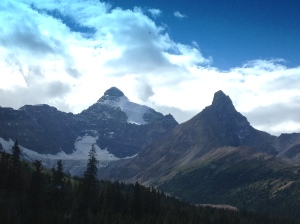Banff National Park may be the most frequented park in Canada. As with most National and Provincial parks here, it has a city as the central point. Banff (the city) is a bustling little tourist trap. It has 4 main streets filled with the typical t-shirt/fudge/souvenir/mukluk store and then a smattering of local and chain restaurants. The parking is mostly reserved for tour buses of all shapes and sizes. But we waded through the masses to pick up our requisite sticker and then headed back into the mountains. 
Banff (the park) offers many hiking trails and beautiful vistas.  but the camping is crowded and close and there is no really any areas to get off-road and enjoy the quiet.
but the camping is crowded and close and there is no really any areas to get off-road and enjoy the quiet.
We moved on down the Icefield Highway to Jasper National Park. This begins where Banff left off and includes more of the Canadian Rockies. The Icefield Highway passes through some seriously HUGE, unable-to-capture-on-camera-sized mountains that are jagged and craggy. Many of them have huge snow heaves falling off their edges, and glaciers formed in the valleys between them.  This is a vast expanse of space (with just one gas stop, so use it!) that leaves ones mouth agape.
This is a vast expanse of space (with just one gas stop, so use it!) that leaves ones mouth agape.
Near the end of this section of roadway is the Icefield Glacier Info Center. That sign should say “Sacrificial glacier stop ahead” because this is a tourist trap of the finest quality.  Hundreds of folks are lined up inside to ride a sky-tram or take a coach-bus to the tip of the glacier. There they will pull out their selfie-sticks and snap a few shots, touch the ice with bare fingers and declare “ooooo, it’s so cold” and climb back into their $39.95 transportation to return to the parking lot and pose with the fiberglass animals.
Hundreds of folks are lined up inside to ride a sky-tram or take a coach-bus to the tip of the glacier. There they will pull out their selfie-sticks and snap a few shots, touch the ice with bare fingers and declare “ooooo, it’s so cold” and climb back into their $39.95 transportation to return to the parking lot and pose with the fiberglass animals.  All of this happens with nearly ZILCH acknowledgment of how far the glacier has retreated in recent years, or how few glaciers even exist any more, or the disappearance of bees or any other global/environmental concern that really could be driven home in this beautiful, high-traffic location.
All of this happens with nearly ZILCH acknowledgment of how far the glacier has retreated in recent years, or how few glaciers even exist any more, or the disappearance of bees or any other global/environmental concern that really could be driven home in this beautiful, high-traffic location.
Jasper National Park ends quietly with grassy, tree covered rolling hills and small lakes. We even saw a couple herds of bison feeding near the road.  The roads are evidence of the icy cold winters, not the asphalt crack running under the van in this photo! The plants are huge and healthy as they thrive with 18 hours of sunlight and frequent rain showers. Look at these rose hips!
The roads are evidence of the icy cold winters, not the asphalt crack running under the van in this photo! The plants are huge and healthy as they thrive with 18 hours of sunlight and frequent rain showers. Look at these rose hips! 
One more feature of Jasper NP is Miette Hot Springs. This is a modern structure around a natural mineral hot spring. As with Radium Hot Springs in Kootenay, this one is chlorinated and built up with a shower house, concrete pool, benches, a café and hefty admission price. But the warm water was a welcome relief after a day of driving. And we met some great people at the campground.
This wraps up our journey through these 4 national parks. By now our “Parks Canada” pass has paid for itself many times over and we have enjoyed the national parks in the Eastern shores and the Western mountains with just a couple more to go!

beautiful
Geneva, the Icefields Info Centre used to be carefully tracking and showing the retreat of the glacier, and other environmental concerns – but it is to Canada’s shame that the current Conservative government has ordered an end to any public information (including from National Parks run by Parks Canada) that might suggest global climate change is happening (the Conservatives are ‘married’ to the oil industry). As an ordinary Canadian and fellow Vanagonite, I apologise to you that such shameless ignorance of the environment is now on display in my country.
Awesome!